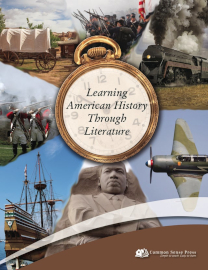Learning American History Through Literature serves as a guide for a unit-study-style course by utilizing real books, discussion, and activities. It can be used as your core history curriculum or as a supplement for one or two years.
The book’s preface says that it can be used with students in kindergarten through eighth grade, allowing you to teach a wide range of ages together. In my opinion, it should work best for students up through sixth grade.
The course divides American history into seven periods: Colonial, Revolutionary War, Westward Expansion, Civil War, Industrial Age, World War Years, and Postwar Years. You can see from these period headings that it skips over the period of the explorers, and the final period covers only through the 1960s. The course is intended to serve as an introduction to American history rather than as comprehensive coverage. This is fine for younger students, but students beyond sixth grade really need to cover the last half century of American history.
The material for each time period is presented in the same order. It begins with a brief “Prologue” summarizing the key events leading up to the period. The next section, labeled “Setting,” is a short list of two to six books that provide an overview of the period. The instructions say to read all of them or other books that cover the time period, but some of the listed books will be too young or too old for some students. The suggestions range from short books for younger students, such as Going West, a 48-page picture book recommended for kindergarten through third grade, to Magic Treehouse Fact Tracker: World War II, a 144-page book recommended for those in grades four through seven. (The number of pages and age range is listed for each of the Setting books.)
Following the Setting booklist are vocabulary words and their definitions. A crossword puzzle for each section is in the appendices along with a few other strategies for learning the vocabulary.
“The Plot” section that comes next is likely to take the bulk of your time. This section has lengthy, annotated lists of books—under the headings “Short Books” and “Chapter Books”—plus a short list of coloring and activity books. In contrast to the Setting books, each of the Plot books has a narrower focus. Most of them are biographies and historical fiction, with age ranges indicated.
The guide suggests that while reading some of the Plot books you also skip ahead to the “Reading Between the Lines” section and choose from the suggested activities those that dovetail with the Plot books you are reading. The activities include movies to watch, map work, crafts, field trips, games, projects, and cooking (recipes included). Reproducible pages at the back of the guide are used for some activities including the construction of a Lap Book of the Constitution. Some of the hands-on activities will appeal to various types of learners, and some will serve to keep the interest of younger students.
A “Dialogue” section found between “The Plot” and “Reading Between the Lines” presents suggested discussion questions (with answers) that you might use at appropriate times.
The layout is very flexible. Choose the books and activities you want and use them in the order that works for you. You might do less with younger children and more with those who are older.
Among the recommended books are many older titles still in print, such as Prairie School by Lois Lenski (1951) and Old Yeller by Fred Gipson (1958). There are also some more-recently published books, but the selection is light on coverage of Native Americans. The section on the postwar era includes a few books (and discussion questions) on desegregation, discrimination against Black people, and the beginnings of the Civil Rights movement, but keep in mind that the study ends with the 1960s. The flexibility of the course allows parents to decide how much time to spend on various topics, and you might want to add books not listed in the guide.
The final page in each section, titled “Epilogue,” is most useful for older students. Each Epilogue has a list of key people on whom students can research and report. The second item in the Epilogue suggests major events, people groups, or places pertaining to the time period for students to research; ideas for different types of research presentations are on page 140. The third Epilogue suggestion is to search out YouTube® videos related to the time period for viewing. The final suggestion is for students to create a timeline to put events into their historical context. The page following the Epilogue lists events and dates, and page 141 offers suggestions for creating the timeline.
Older students need to do some written work for the course, most easily accomplished with the vocabulary words and the two research assignments.
Political Viewpoints
Political and cultural viewpoints can be problematic in studies such as this if you stick to the recommended books. Some families will want more coverage of disadvantaged groups than is included in this guide. Other families might prefer to use some of the recommended older books because they tend to present a more positive view of American history, while other families want their children to learn more about the negative side of American history. The design of this study allows you to choose other books than those listed to cover the time periods in a way you prefer.
Summary
Learning American History Through Literature should be an interesting resource for parents who like to pick and choose from suggested resources and construct their own program from the recommendations.









